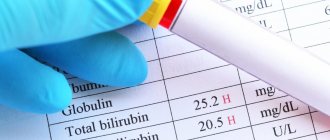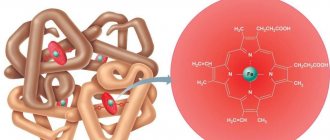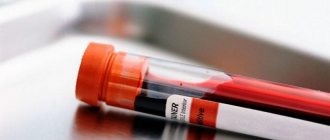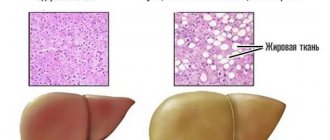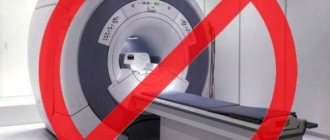Low bilirubin (up to 7-8 µmol/l) is considered an independent risk factor for vascular diseases (heart attack, stroke), seasonal depression, and in children it shows the likelihood of intracerebral hemorrhage and neonatal retinopathy. This is due to the antioxidant properties of bile pigment. The reasons for the decrease include a lack of red blood cells and hemoglobin, aplastic anemia (bone marrow damage), leukemia, tuberculosis, and renal failure.
In the absence of symptoms and low indicators, you need to retake the test, taking into account the preparation rules - excluding alcohol, smoking, coffee at least 24 hours before. For 3-5 days, medications that reduce bilirubin are discontinued: sleeping pills, anticonvulsants, Corvalol, painkillers, vitamin complexes, hormones, antibiotics.
What if the child’s total bilirubin is low?
Bilirubin is a constant component of bile and is also part of the blood of a healthy person.
Direct bilirubin is a mixture of indirect bilirubin with albumin, which helps dissolve this pigment. as well as removing it from the body naturally. Bilirubin must be present both in the child’s blood and urine. Exceeding normal values, or their significant decrease, indicates pathological disorders that occur in the liver or other organs. So, if the child’s total bilirubin is low. In the first weeks of life, it is quite typical to see a significant increase in bilirubin in the child’s body, which is triggered by the breakdown of additional hemoglobin that the child received in the womb. After just one month of life, these indicators return to normal. If this does not happen, you should seek help from specialists.
In addition to the fact that increased bilirubin has a negative effect on the human body, if the total bilirubin in a child is decreased, the indicators may also indicate pathological changes in the functioning of internal organs. If total bilirubin in a child is low, this may indicate viral hepatitis or other liver damage, obstructive jaundice, the presence of nutritional dystrophy, congenital jaundice or other problems of the liver and pancreas.
Any changes in the concentration of bilirubin in the human body may indicate problems with internal organs, therefore it is strictly forbidden to reduce or increase the amount of bilirubin using medications or folk remedies without consulting a doctor and in-depth examination. The concentration of bilirubin is a symptom of a disease, by curing which you will return all indicators to normal.
Bilirubin is one of the main components of bile. Bilirubin is formed from the blood pigments of erythrocytes, that is, it is a product of the breakdown of hemoglobin (in smaller quantities, bilirubin is formed during the breakdown of myoglobin and cytochrome).
After the breakdown of hemoglobin, free (indirect) bilirubin is formed, which, in combination with albumin, is transported from the spleen tissue to the liver.
In the liver tissue, free bilirubin binds to glucuronic acid and converts it into a bound (direct, conjugated) fraction of bilirubin. The conjugated fraction of bilirubin is actively excreted into the bile ducts.
Direct and indirect bilirubin in the blood
When performing a test for bilirubin in the blood, the level of total and direct bilirubin fractions is assessed. Indirect bilirubin is calculated by calculating the difference between these values.
Indirect bilirubin = total bilirubin fraction – direct bilirubin fraction.
The amount of direct bilirubin can be up to 25% of the total fraction. The remaining 75% is indirect bilirubin.
The direct fraction is the result of the combination of bilirubin with glucuronic acid. It is low toxic and water soluble. Its increase in the blood serum may be due to a reduced level of excretion of conjugated pigments from the liver, obstruction and inflammation of the biliary tract, amoebiasis, opisthorchiasis, infectious mononucleosis, etc.
Also, with a sharp increase in the direct bilirubin fraction, it can be detected in the urine. The indirect fraction of bilirubin is not excreted in the urine.
Indirect bilirubin is a fat-soluble and highly toxic substance.
Its concentration may increase with hemolytic anemia (increased breakdown of red blood cells), pulmonary infarction, rupture of aortic aneurysm, malaria, neonatal jaundice, sepsis, Gilbert's syndrome, etc.
When is a bilirubin test prescribed?
A bilirubin level test is prescribed for:
- various jaundices;
- carrying out differential diagnosis of types of jaundice;
- suspected hyperbilirubinemia;
- cholestasis (stagnation of bile);
- cholelithiasis;
- liver diseases;
- diseases of the biliary tract;
- hepatosplenomegaly (enlarged liver and spleen);
- infectious diseases accompanied by liver damage;
- taking medications that have hepatotoxic effects;
- hemolytic anemia;
- diseases of the cardiovascular system.
Routine determination of bilirubin levels is carried out in newborns and pregnant women.
How to take a bilirubin test?
A blood test for bilirubin must be taken on an empty stomach. At least twelve hours must pass since the last meal. Also, during this time, it is forbidden to drink juices, tea and coffee (drinking coffee on the eve of tests can lead to a falsely low level of bilirubin in the blood).
It is allowed to drink non-carbonated water.
Before the study, it is necessary to exclude psycho-emotional and physical stress.
It is advisable to avoid alcohol intake a week before the test (at least 48 hours).
The attending physician and laboratory staff must be notified about the medications you are taking, since many medications can affect the level of bilirubin in the blood, lowering or increasing it.
The drugs acyclovir, acebutol, allopurinol, amitripline, captopril, clindamycin, penicillin, doxycycline, cephalosporin antibiotics, NSAIDs (nonsteroidal anti-inflammatory drugs), antimalarial drugs, antifungal drugs, etc. can increase the level of bilirubin in the blood.
Reduced bilirubin in a child or adult can be observed during treatment with amikacin, theophylline, anticonvulsants, etc.
How to adjust indicators
Without identifying the cause, it is impossible to normalize bilirubin levels. Treatment of the underlying disease and proper nutrition are required. Since a decrease most often occurs with anemia, it is important to ensure the supply of iron and vitamins. To do this, the menu should include:
- liver, veal, beef;
- fish dishes and seafood;
- egg yolk;
- buckwheat and oatmeal;
- peaches, kiwi, apricots, apples;
- strawberries, black currants;
- fresh greens.
Fatty meats, fried and spicy foods, sausages, smoked meats, and bran should be excluded from the diet. Separate meals should include milk, coffee and tea, as they interfere with the absorption of iron from foods.
For tuberculosis infection, you need a nutritious, high-calorie diet rich in protein. Milk, calcined cottage cheese, fresh juices, fruits, berries and vegetables are useful.
If renal failure is detected, then the diet is based on the filtration capacity of the kidneys. General recommendations:
- base – cereals, vegetables and fruits;
- fish, lean meat, fermented milk drinks, cottage cheese are allowed;
- limit salt, sausages, canned food, marinades.
Low bilirubin in the blood occurs when the hemoglobin level decreases due to anemia, kidney failure, tuberculosis, and leukemia. Reduced levels are considered a risk factor for coronary heart disease and other vascular diseases.
Normal bilirubin level in blood
The level of bilirubin in the blood is measured in µmol/l.
The level of total bilirubin in newborn babies in the first hours of life is within the following limits:
- twenty-four hours of life - bilirubin levels can reach 137;
- forty-eight hours of life - up to 222;
- eighty-four hours – 290.
In babies older than one month of life, the level of total bilirubin should be from 3.4 to 17.0 (more information about the norms in children in a special material here).
The level of bilirubin does not depend on gender, so its levels in adult men and women do not differ and normally range from 3.4 to 20.5
The level of direct bilirubin in adults should be less than five.
What does it mean if an adult has low total bilirubin?
Low bilirubin in the blood can be associated with exhaustion, anemia, taking drugs that reduce bilirubin, etc.
Also, a decrease in direct and indirect bilirubin is observed in patients undergoing treatment with amikacin, anticonvulsants, theophylline, etc.
Causes of low bilirubin in the blood in adults:
- severe cardiovascular pathologies (coronary heart disease);
- non-hemolytic anemia (chronic or acute posthemorrhagic anemia);
- tuberculosis;
- chronic renal failure;
- acute and chronic leukemia.
Also, reduced bilirubin levels can be observed in premature babies, malnourished or weakened patients, people on low-calorie diets, and smokers.
A decrease in bilirubin levels can be caused by drinking coffee on the eve of the test, prolonged exposure of the patient to the sun (hyperinsolation) or exposure to sunlight on the blood taken for analysis (improper storage of samples).
Frequently asked questions about analysis. Part - 4
What is the normal level of total bilirubin in a blood test?
Common bilirubin is a yellowish-brown, sometimes reddish pigment in the body, which is formed through the breakdown of hemoglobin and some other blood elements. The pigment is produced, for the most part, in liver cells, and is present mainly in the composition of bile. Sign up for a blood test for bilirubin.
There are 2 main forms of bilirubin in blood serum: direct and indirect, together they create a general indicator that has important diagnostic value in identifying many gastrointestinal diseases and liver pathologies.
To determine the level of pigment substance in the blood, a biochemical analysis is performed, which is necessary in the diagnosis of various internal diseases. The norm of total bilirubin in the blood of women differs slightly from the established values for men and small children.
The normal level of total bilirubin in the blood of adults varies from 3.4 to 17.1 µmol/l. It is believed that when the pigment level is more than 20 µmol/l and in higher concentrations, the toxic pigment begins to negatively affect the body, poisoning it. However, when testing blood for pigment, it is often necessary to analyze its main fractions, namely:
- Direct (or bound) bilirubin, which makes up almost 30% of the total amount of pigment substance, normally ranges from 0 to 5.3 µmol/l. This subtype of bilirubin within acceptable limits does not pose a danger to the body, because it is bound and about to leave the bloodstream naturally. This indicator increases when various obstacles appear during the development of pathological processes.
- Indirect (or unbound) bilirubin occupies the bulk of the total amount. Normally, it should be no more than 1.7-17 µmol/l. It is this subtype of pigment that can move freely, quickly accumulate in the blood, and at high concentrations can quickly poison the body.
It is important to note that when testing blood for pigment in different laboratories, the standard values may vary slightly due to the use of reagents of different characteristics, and other features of the analysis.
The general norm for bilirubin in children, especially in newborns and young children, can differ greatly from “adult” indicators. Immediately after birth, bilirubin in the baby’s blood can reach levels of up to 105 µmol/l. In the following days, the level of pigment may increase even more, up to 250 µmol/l, which can affect the skin and mucous membranes of infants, causing them to become excessively yellow. By the end of the 1st week, normally, the bilirubin level should gradually decrease. Such a large concentration of bile pigment is not considered a pathology, and in medicine is called physiological jaundice.
The general norm for bilirubin in women during pregnancy does not change from the established values, since the level of yellow pigment is not affected by either hormones or other changes occurring in the body of the expectant mother. The only thing is that in the later stages of pregnancy, the outflow of bile from the biliary streams may be slowed down due to physiological reasons, due to which a slight increase in total bilirubin may be observed.
Why is total bilirubin increased in a blood test?
An increase in the level of pigment substance in the body above 17.5 µmol/l is called hyperbilirubinemia. If a patient has elevated total bilirubin, when the values are several times (or even several dozen times) higher than the established limits, this condition signals the development of serious diseases in the body, which can be extremely dangerous to human health and life.
The reasons for increased total bilirubin in the blood can be very diverse, but as a rule, they come down to the main 3 types of possible disorders, namely:
- Hemolysis (accelerated destruction of red blood cells)
- Liver disorders that impair the formation, binding or proper elimination of bilirubin
- Impaired proper flow of bile
For a doctor, high total bilirubin in a patient may be a reason to suspect the following pathological conditions:
- Hepatitis (various types)
- Liver cancer/cirrhosis
- Acute infectious liver lesions (eg syphilis)
- Cholelithiasis
- Cholecystitis
- Mononucleosis
- Tumor formations in the liver, bile ducts and pancreas
- Lack of vitamin in the body. AT 12
- Liver poisoning by toxic substances (medicines, alcohol, etc.)
The main reasons for the increase in total bilirubin in the blood are listed above. But we also cannot fail to mention a rather rare genetic pathology that is inherited from parents to a child - Gilbert's syndrome. With this disease, there is a significant lack of special enzymes in the liver that are responsible for processing indirect, most toxic bilirubin.
Treatment for elevated total bilirubin
Before proceeding to treatment of increased bilirubin, you should find out the reason why the normal metabolism and removal of pigment was disrupted. In the future, all therapeutic measures should be aimed at treating the underlying disease or pathology of the internal organs.
If the bilirubin level reaches critical levels, infusion therapy is often used, which consists of intravenous administration of glucose and detoxification drugs to the patient. Such manipulations accelerate the processes of decay and removal of toxic pigment from the body.
There is another method of treating this condition - phototherapy. This procedure involves irradiating a person with special lamps, under the influence of which the most toxic type of bilirubin, indirect, is destroyed. As a rule, this method is used to quickly reduce pigment in newborns.
In addition to drug treatment, it is recommended to reduce as much as possible any load on the liver, this means stopping the use of all “heavy” medications, excluding fried, spicy, sweet foods, carbonated and alcoholic drinks from the daily menu.
What does low total bilirubin mean?
Despite the fact that in medical practice an increase in the pigment substance in the body causes great concern, there are cases when total bilirubin is reduced. Although this phenomenon is extremely rare, in some cases it can have serious implications when examining a patient.
The causes of low total bilirubin may be associated with renal failure, acute leukemia, tuberculosis, or aplastic anemia.
But, nevertheless, most often the patient is found to have low bilirubin due to improper preparation or donation of blood for testing. This mainly concerns poor nutrition, consumption of caffeine-containing products on the eve of the test, as well as excessive consumption of ascorbic acid, which can also subsequently lead to distorted results.
We hope that now you have fully learned about total bilirubin, what it is and why it is necessary to study this pigment.
‹ Previous page | Next page >
Symptoms of low direct and indirect bilirubin
There are no specific symptoms of low bilirubin in the blood. With non-hemolytic anemia, the patient will be bothered by constant weakness, drowsiness, dry and pale skin, brittle nails, hair loss, decreased vision, etc.
Patients with coronary heart disease will experience weakness, shortness of breath, and fatigue.
Patients with tuberculosis will experience prolonged cough, weakness, pale skin, weight loss, prolonged fever, and night sweats.
Is low bilirubin dangerous?
Low bilirubin in the blood is a decrease in the total indicator to 3.4-7 µmol/l. Previously, bile pigment was considered the final product of hemoglobin metabolism of destroyed red blood cells, which must be removed from the body. Therefore, a decrease or absence in the blood was not considered dangerous for the body.
It was subsequently observed that patients with benign Gilbert's hyperbilirubinemia (high bilirubin in the blood) were less likely to have myocardial infarction and stroke. It has been suggested that this substance plays the role of the main antioxidant, that is:
- protects blood vessels from destruction and development of atherosclerosis;
- neutralizes the harmful effects of free radicals formed due to lack of oxygen, diabetes, inflammation;
- prevents extensive liver damage due to viral and toxic hepatitis.
It was proposed to consider bilirubin levels less than 7 µmol/l as one of the risk factors:
- coronary heart disease (angina pectoris, heart attack);
- development of cerebrovascular accidents (transient ischemic attacks, brain damage due to dyscirculatory encephalopathy, ischemic stroke);
- seasonal depressive disorders;
- obesity;
- diabetes mellitus
A newborn may have low levels if:
- impaired development of the respiratory system (bronchopulmonary dysplasia);
- severe intestinal inflammation (necrotizing enterocolitis);
- damage to the retina of the eyes (retinopathy);
- hemorrhage in the ventricles of the brain;
- general low antioxidant status.
The role of bilirubin in these diseases is not only to protect tissues from damage (antioxidant), but also to participate in immune reactions and the progression of inflammation. A low level of bile pigment in itself cannot cause diseases, but it determines their more severe course.
There is an assumption that a decrease in bilirubin is accompanied by early aging, a person looks older than his age (gray hair, wrinkles). Also, a drop in the indicator is more dangerous for men and women during menopause, since estrogens (female hormones) prevent vascular diseases.
Treatment of low bilirubin levels in the blood
All treatment should be prescribed exclusively by the attending physician after identifying the cause of the decrease in bilirubin.
The prescribed medications depend on the underlying disease that caused the change in the tests.
If total bilirubin in an adult is low, this means that serious illnesses are possible. Such indicators are caused, for example, by renal failure, tuberculosis, anemia, and ischemic disease. Another possible option is improper preparation for a biochemical blood test. In any case, one cannot rest until the cause of the decline is discovered.
Bilirubin below normal: reasons
The reasons that bilirubin in the blood is below normal may be associated with diseases (anemia, leukemia, tuberculosis, renal failure) and violations of the rules for preparing for blood collection, its storage and transportation. Therefore, the low indicator itself never becomes the basis for making a diagnosis; in the absence of complaints and changes in other examination data, the analysis must be repeated with proper preparation.
Anemia
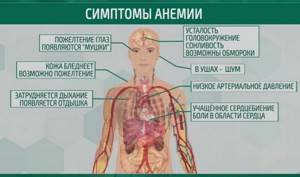
The most common reason for a true decrease in bilirubin in the blood is insufficient hemoglobin content, that is, the source for the formation of bile pigment. This may happen when:
- acute or chronic blood loss;
- insufficient intake of iron or poor absorption through the intestines;
- deficiency of vitamins, especially B12 and folic acid;
- inhibition of red blood cell formation (aplastic anemia);
- the use of toxic drugs, often antitumor drugs, antibiotics, to reduce the formation of thyroid hormones, treatment of malaria;
- working with gasoline, varnishes, paints, pesticides;
- irradiation, radiation therapy;
- previous viral hepatitis, influenza, infectious mononucleosis;
- pregnancy;
- tumor diseases.
Symptoms of anemia may be absent, then it is found only in blood tests, but weakness, fatigue, shortness of breath and palpitations with light exertion, tinnitus, darkening of the eyes, pale skin are also possible. After the formation of red blood cells normalizes, the level of bilirubin also increases.
Leukemia
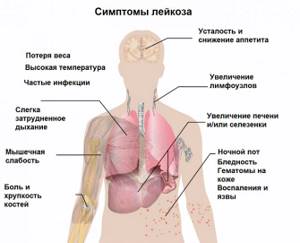
With tumor diseases of the blood, the level of red blood cells and hemoglobin sharply decreases, which leads to low bilirubin levels. You can suspect him by:
- severe fatigue;
- pain in bones and joints;
- elevated temperature;
- pale skin with an earthy tint;
- enlarged lymph nodes;
- frequent sore throats, respiratory diseases;
- sweating;
- lack of appetite.
To detect leukemia, a blood test and bone marrow puncture are prescribed. For treatment, droppers with antitumor drugs, bone marrow and stem cell transplants are recommended.
Tuberculosis

Tuberculosis infection can be hidden and low bilirubin is one of the indicators that requires excluding infection. If you are asymptomatic, you need to undergo a Mantoux or Diaskintest test, take blood tests (T-spot, quantiferon test), and in case of cough, sweating and severe weakness, a chest X-ray must be immediately prescribed.
The doctor may also become suspicious if:
- prolonged elevated body temperature;
- loss of appetite, emaciation;
- painful blush on the cheeks;
- secretion of sputum with blood.
Anti-tuberculosis drugs are used for treatment.
Kidney failure
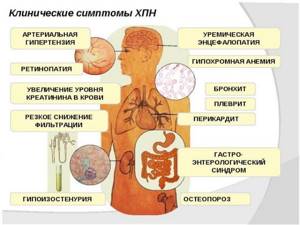
Since the hormone for stimulating hematopoiesis (erythropoietin) is produced by the kidneys, when they are severely damaged, a severe form of anemia develops. The formation of blood cells also deteriorates due to the accumulation of protein metabolic products. Symptoms of kidney failure include nausea, vomiting, swelling, and decreased urine output. Hemodialysis and kidney transplantation are used for treatment.
Decreased bilirubin outside of disease
The patient’s normal state of health and the absence of changes in the general blood test give reason to assume violations of the rules for preparing for a blood test:
- drinking coffee, alcohol;
- prolonged exposure to the sun, visiting a solarium;
- the use of drugs that reduce bilirubin: Phenobarbital, Heparin, Aspirin, Eufillin, Corvalol, Prednisolone, antibiotics, anticonvulsants;
- droppers with solutions before taking blood;
- starvation;
- smoking.
When storing or transporting a blood sample in sunlight, the content of bile pigment decreases.
What leads to a decrease in bilirubin
The phenomenon of decreased bilirubin in the blood has not yet found an exact physiological explanation in modern medical science. But many studies confirm the connection between a reduced rate and the presence of serious diseases.
Incorrect preparation for the test
A decrease in bilirubin in the blood in some cases is explained by such a banality as non-compliance with medical instructions before taking the test.
The amount of total bilirubin in the blood is affected by:
- large amounts of caffeine or alcohol drunk the day before;
- excess vitamin C;
- use of medications (choleretic agents, hepatoprotectors, Aspirin, Phenobarbital, Theophylline, Heparin);
- physical exhaustion due to hunger or lack of nutrients in the diet.
Errors by medical staff can also be included in this category. The doctor will advise you to retake the test, but taking into account all the preparatory measures.
Kidney failure
Low bilirubin in the blood occurs with kidney disease. In adults, kidney failure develops due to:
- mechanical obstruction of the urinary tract due to urolithiasis;
- inflammation, cysts, neoplasms in the kidneys;
- heart diseases;
- hormonal disorders.
Failure to perform the basic functions of the urinary system leads to water, electrolyte, nitrogen imbalance, and failures of other metabolic processes. As a result, decreased bilirubin is observed.
Acute leukemia
Low bilirubin constantly accompanies leukemia, or blood cancer. Low bilirubin in a child should cause serious concern among parents.
In adults, leukemia develops due to exposure to chemicals or radioactive substances, as well as smoking. The state of health in this pathology is characterized by decreased immunity, increased bleeding, and anemia quickly develops.
To diagnose pathology, the total number of leukocytes and the presence of blast cells in the blood are determined.
Tuberculosis
Low bilirubin is associated with another infectious disease caused by mycobacteria, or Koch bacilli, tuberculosis.
Most often, bacteria settle in the lungs, kidneys, and tubular bones. When mycobacteria infect an organ, inflammation develops and tubercles characteristic of the disease form, which disintegrate over time. In this case, the processes of binding and excretion of bilirubin are disrupted.
The disease becomes active in only one in ten carriers of the tuberculosis bacillus.
Reduced bilirubin should prompt a diagnosis to confirm or refute the presence of tuberculosis.
Aplastic anemia
Bilirubin below normal is found in patients with aplastic anemia. This is a serious disease of the blood system. It affects the bone marrow, causing the production of blood cells to cease.
Aplastic anemia develops due to poisoning by certain chemicals, drugs, infections and radiation. Hereditary factors play a significant role in the development of the disease.
- frequent dizziness;
- fast fatiguability;
- tachycardia;
- bleeding
Other reasons
Low bilirubin in the blood, especially in older people, is a possible symptom of coronary heart disease. The pathology is accompanied by a violation of the blood supply to the heart muscle, due to which the heart does not receive enough oxygen.
Ischemia is the most common disease of the heart and blood vessels. Stroke, heart attack, sudden coronary death are manifestations of the disease.
The risk group includes:
- aged people;
- men;
- patients with diabetes mellitus;
- obese;
- smokers;
- lovers of alcoholic beverages;
- leading a passive lifestyle.
Causes of low bilirubin
For children and adult men and women, the causes of low bilirubin are the same, but there are differences in the frequency of their occurrence. There are features of pigment metabolism during pregnancy.
In a newborn
Low bilirubin in a newborn can result in:
- intrauterine infection;
- birth before term (in premature infants);
- congenital diseases with impaired hemoglobin formation;
- treating jaundice with phototherapy or medications;
- deficiency of iron, cobalt, copper, folic acid and vitamin E in the mother’s diet during pregnancy.
An extensive blood test is usually sufficient to make a diagnosis. Treatment begins with eliminating the cause, and for premature babies only proper care is needed.
Among women
For women outside of pregnancy, low bilirubin is most often associated with blood loss during heavy menstruation, drinking coffee and/or medications 24 hours before donating blood. Less commonly, reduced rates are explained by:
- kidney damage;
- tumor diseases;
- past infections;
- long-term inflammatory processes;
- decreased or increased thyroid function;
- autoimmune diseases (formation of antibodies to one’s own tissues).
During pregnancy
During pregnancy, a decrease in the level of bile pigment usually occurs against the background of anemia. It is caused by iron deficiency due to its increased consumption, and the concentration may also be reduced due to blood dilution, since in the later stages the volume of circulating fluid will increase in women.
Such changes can be easily detected by a general blood test: decreased hematocrit, red blood cell content and hemoglobin. In case of iron deficiency anemia, it is important to determine indicators of iron accumulation (ferritin, transferrin).
In men
Often, low bilirubin levels are found in men due to smoking, alcohol abuse, and when working with toxic substances. In case of doubt, the following should be excluded:
- tuberculosis infection;
- malignant neoplasms;
- kidney diseases;
- bleeding from peptic ulcers, intestines;
- haemorrhoids;
- chronic inflammation of the digestive system.
Why does bilirubin decrease during pregnancy?
Reduced bilirubin is observed in the blood of women during pregnancy. This is explained by several factors:
- The red blood cell count naturally decreases at this time.
- During the gestational period, many diseases worsen - chronic ones, those in remission. Other pathologies that were not previously apparent also make themselves felt.
Since low bilirubin is associated with kidney disease, tuberculosis, and anemia, it is necessary to detect the main factor threatening the health of the mother and unborn child.
A biochemical blood test during pregnancy is prescribed to confirm or refute the diagnosis.
How to properly prepare for a biochemical study
To avoid possible stress when the test result shows a low level of a substance, and the only reason is poor preparation for the test, you need to follow some simple rules:
- discuss with your doctor and stop taking all medications that may give false readings;
- a few days before the test, moderate physical and psychological stress;
- at least a day before the test, lighten the diet, exclude fried foods that complicate the liver’s function;
- observe the drinking regime, you need to drink plain still water;
- exclude alcohol, coffee;
- do not smoke 3 hours before the test;
- You need to donate blood in the morning on an empty stomach.
How to take blood tests correctly if bilirubin is low
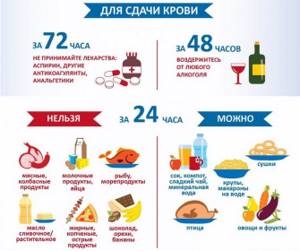
When there are contradictions between symptoms and low bilirubin in a blood test, the doctor must order a repeat test. To obtain an accurate result, it is important to undergo preparation:
- 3-5 days in advance, you need to discuss the possibility of using medications, dietary supplements and herbal medicines that affect indicators;
- You cannot change your diet, fast or overeat within 2 days;
- per day, alcohol, coffee, caffeinated sports drinks, intense physical activity, sunbathing are prohibited;
- dinner the day before should be 8-12 hours before taking blood, then you can only drink clean water;
- in the morning on the day of the analysis you cannot: smoke, play sports, undergo diagnostic tests, physical procedures;
- If you donate blood between 7 am and 11 am, it is better to choose a laboratory with a good reputation, as there may be errors in storage and transportation of the material.
How to increase bilirubin
Low bilirubin itself is not considered a separate disease. This is just one symptom of another disease. Therefore, in order to normalize the level of bile substances, you first need to identify and cure the disease due to which the level is reduced.
If the cause of low bilirubin levels lies in poor diet and lifestyle, it is necessary to take appropriate measures and correct the situation. To normalize pigment levels, you will have to give up alcohol-containing products, caffeine and other stimulants. It is also important to streamline physical activity, since excessive exercise leads to a decrease in pigment levels.
Attention should be paid to correct eating habits: give up harmful ones and wisely use healthy foods.
In cases where low bilirubin is not associated with diseases of the kidneys, heart, or blood, it is treated by giving up bad habits and maintaining a healthy lifestyle.

